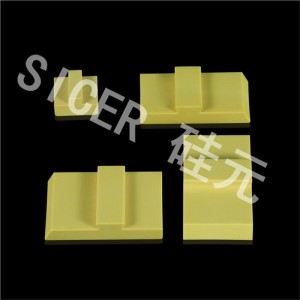Silicon Nitride Ceramic
Short Description:
Production Name: Silicon Nitride Ceramic
Application: Aerospace, Nuclear, Petrochemical, Mechanical Engineering Industry
Material: Si3N4
Shape: Customized
Product Detail
Product Tags
Basic Info
Production Name: Silicon Nitride Ceramic
Application: Aerospace, Nuclear, Petrochemical, Mechanical Engineering Industry
Material: Si3N4
Shape: Customized
Product description:
Silicon nitride ceramics have advantage over metal in many aspects. They are widely used in the fields of aerospace, nuclear, petrochemical, textile and mechanical engineering industries.
Advantage:
·Excellent mechanical property
·Low bulk density
·High strength and hardness
·Low friction coefficient
·Good lubricating function
·Resistance to metal corrosion
·Electric insulation
Products Show


Description:
Silicon nitride ceramics is superior to other materials due to its thermal shock resistance. It does not deteriorate at high temperatures, so it’s used for automotive engines and parts for gas turbines, including the turbocharger rotor.
Ortech offers a complete family of Silicon Nitride materials. These materials have the following key characteristics: No adhesive wear against steel, Twice as hard as tool steel, Good chemical resistance and 60% less weight than steel.
Silicon nitrides (Si3N4) are a range of advanced engineering ceramics characterised by high strength, toughness and hardness and excellent chemical and thermal stability.
Silicon nitride was discovered in the mid-nineteenth century but did not lend itself to ease of fabrication, due to its covalently bonded nature. This initially led to the development of two types of silicon nitride, reaction–bonded silicon nitride (RBSN) and hot pressed silicon nitride (HPSN). Subsequently, since the 1970s two further types have been developed: sintered silicon nitride (SSN), which include the sialons, and sintered reaction–bonded silicon nitride (SRBSN).
The current interest in silicon nitride based engineering materials essentially developed from the research in the 1980s into ceramic parts for gas turbine and piston engines. It was envisaged that an engine, predominately made from silicon nitride based parts, such as sialon, would be light weight and be able to operate at higher temperatures than traditional engines resulting in higher efficiencies. Ultimately however, this goal was not realised as a result of a number of factors including cost, the difficulty in reliably fabricating the parts and the inherent brittle nature of ceramics.
However, this work led to the development of a number of other industrial applications for silicon nitride based materials, such as in metal forming, industrial wear and molten metal handling.
The different types of silicon nitride, RBSN, HPSN, SRBSN and SSN, result from their method of fabrication, which governs their resulting properties and applications.






